Some behaviors I witness in nature remain unexplained even after much thought and review of multiple images documenting them. Such was the case three days ago at a pond near my home.
- Some of the images below are soft and of mediocre quality because I was too close to the birds for the lens I was using, the action was fast a furious, in some cases I didn’t see the birds coming until it was almost too late and I didn’t have time or opportunity to adjust my camera to more appropriate settings. For that reason I won’t be including camera techs below the photos. All images are presented in the order they were taken.
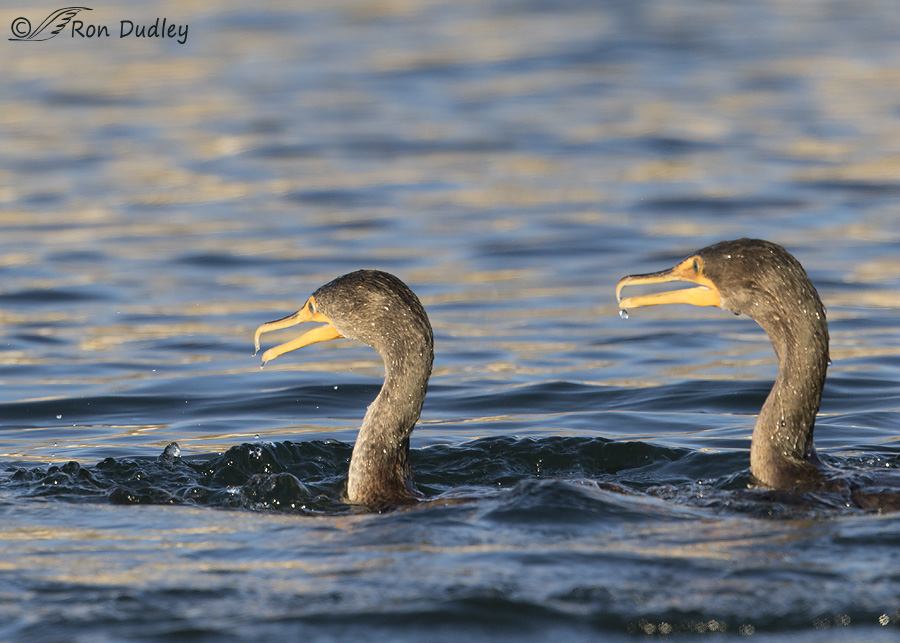
I was photographing birds on the pond that were far away when suddenly two Double-crested Cormorants surfaced in the water very close to me.
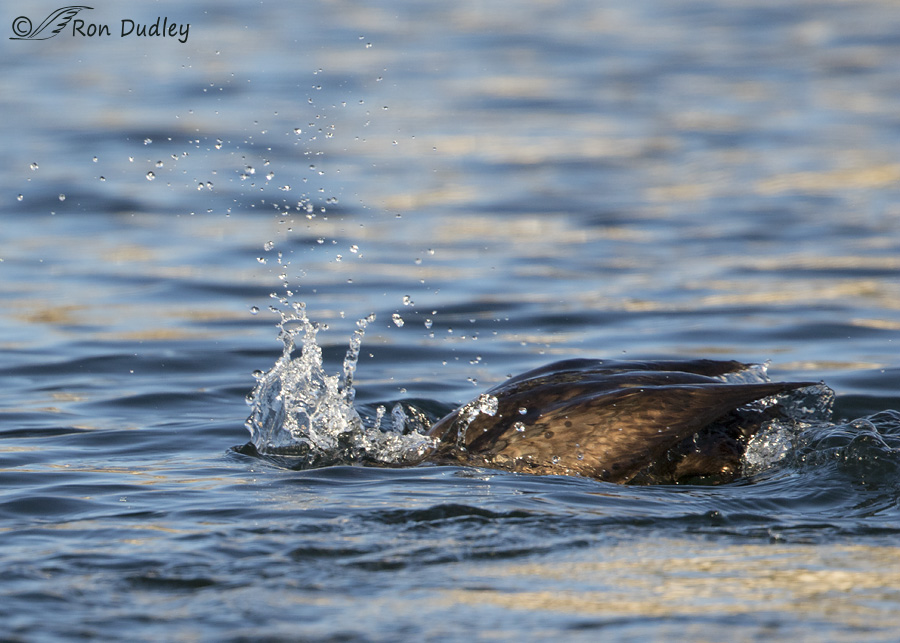
There was obviously something just below the water’s surface that was causing a lot of excitement from both birds as they fought with each other over it but at first I couldn’t tell what it was.
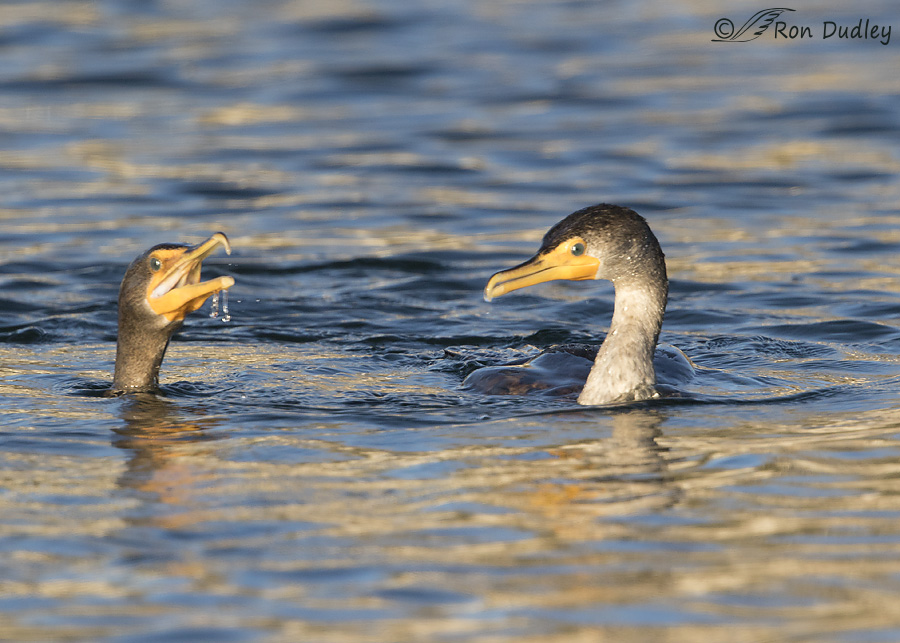
Sometimes they were both underwater and other times just one of them. Here the bird on the left has just emerged.
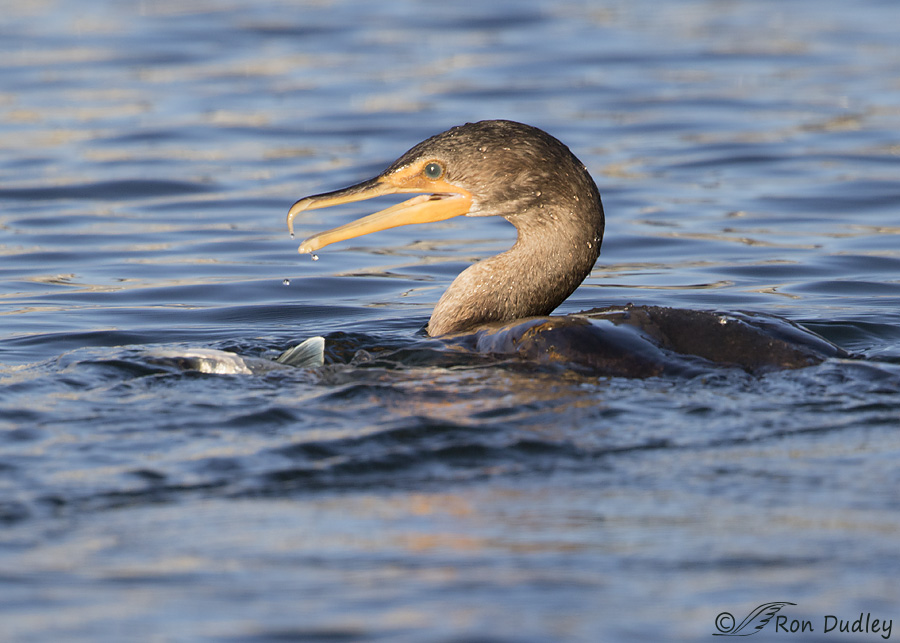
But eventually I got glimpses of a large dorsal fin so I knew the cause of all the excitement was a fish. Both cormorants had the fish in their grasp more than once but each time they deliberately released it.
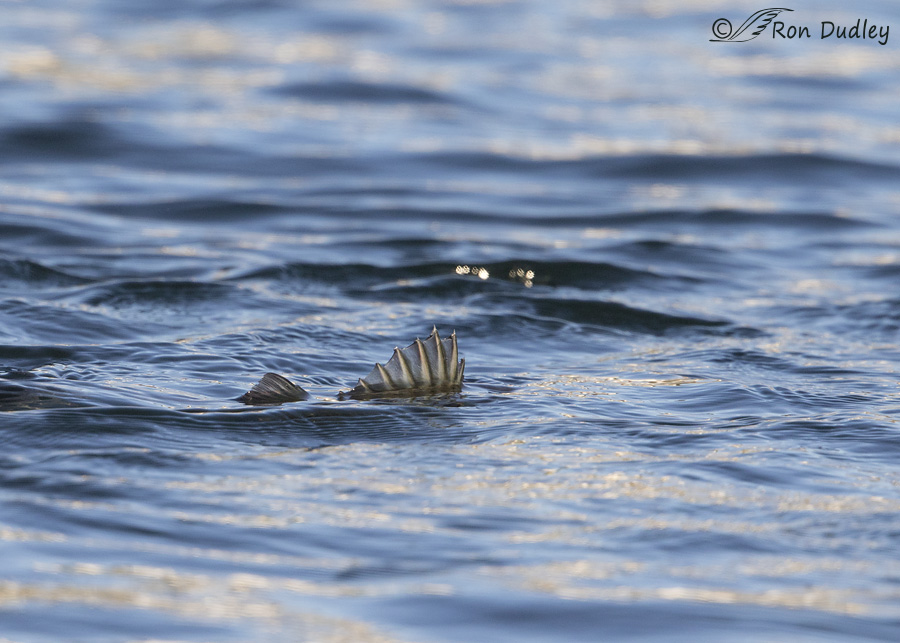
Several times the cormorants swam off and left the fish behind. It was obviously stunned but still alive as it swam very slowly at the surface with its spiny dorsal fins erected.
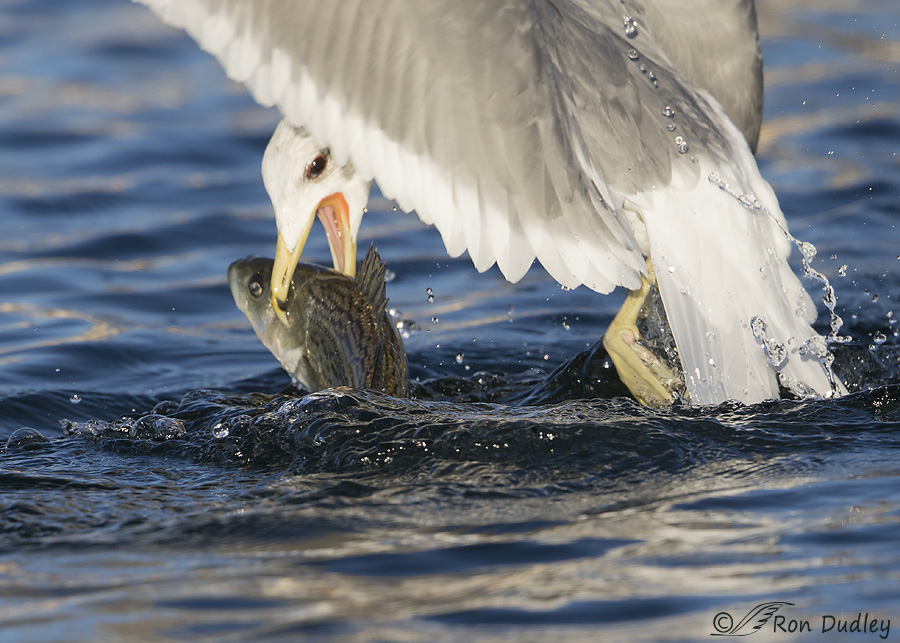
On two separate occasions a California Gull swooped down and grabbed the fish but each time…
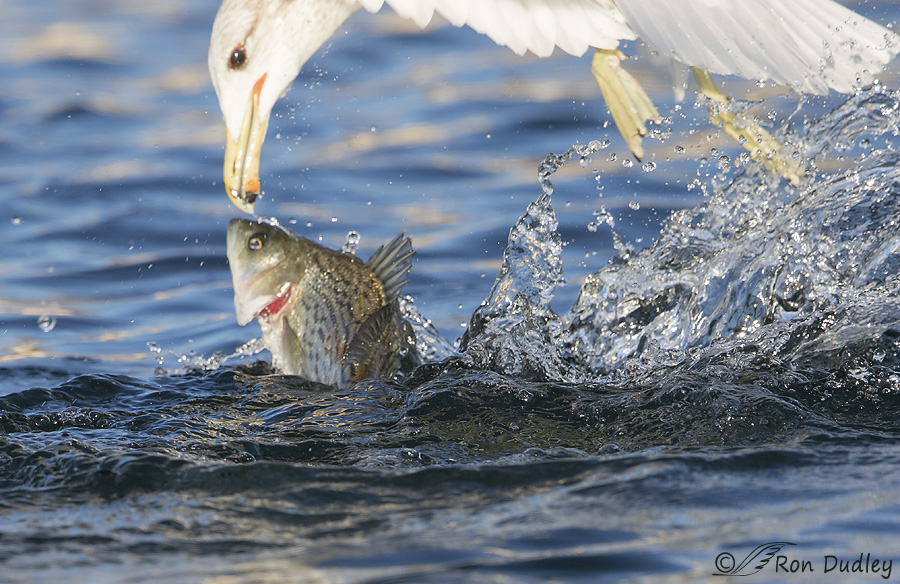
it released the fish almost immediately and flew away.
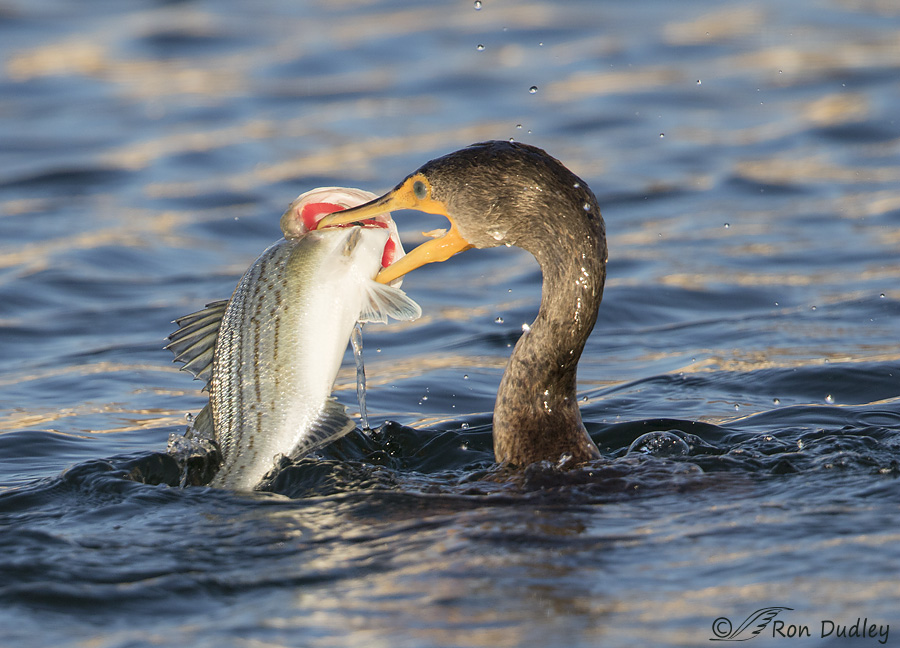
A while later one of the cormorants appeared with the fish in its grasp once again but…
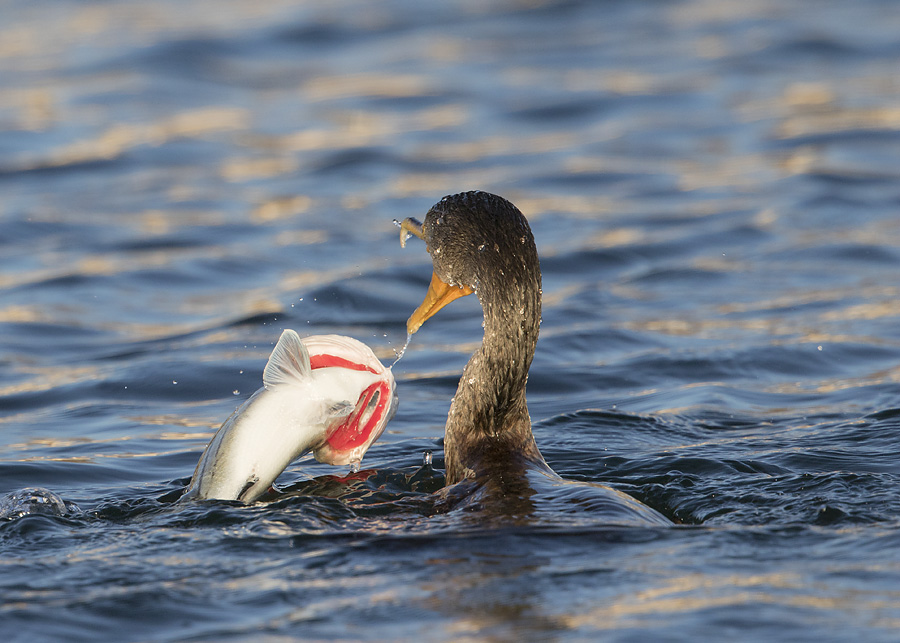
then deliberately released it without even attempting to swallow it and swam away. This happened several times.
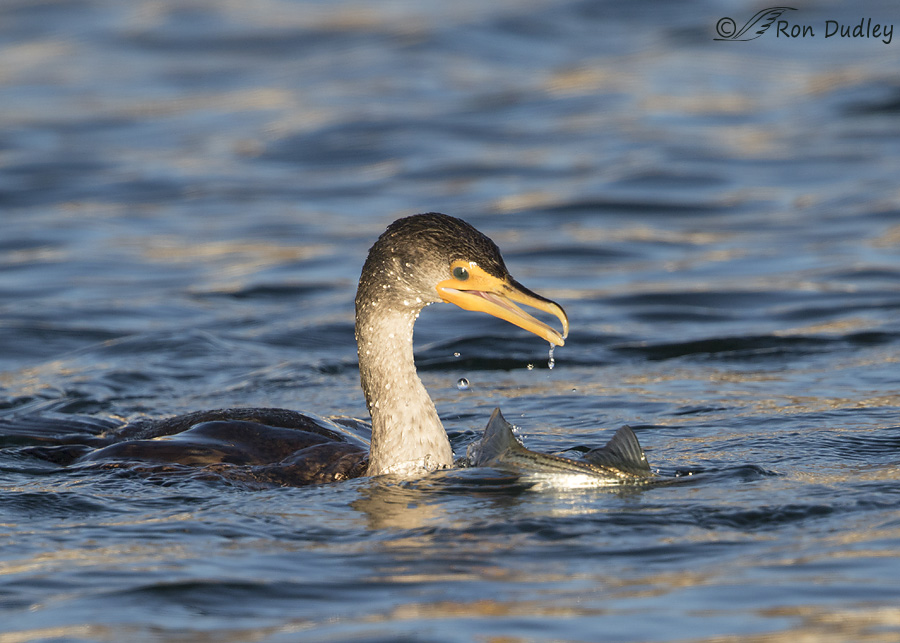
Eventually this cormorant took possession of the fish…
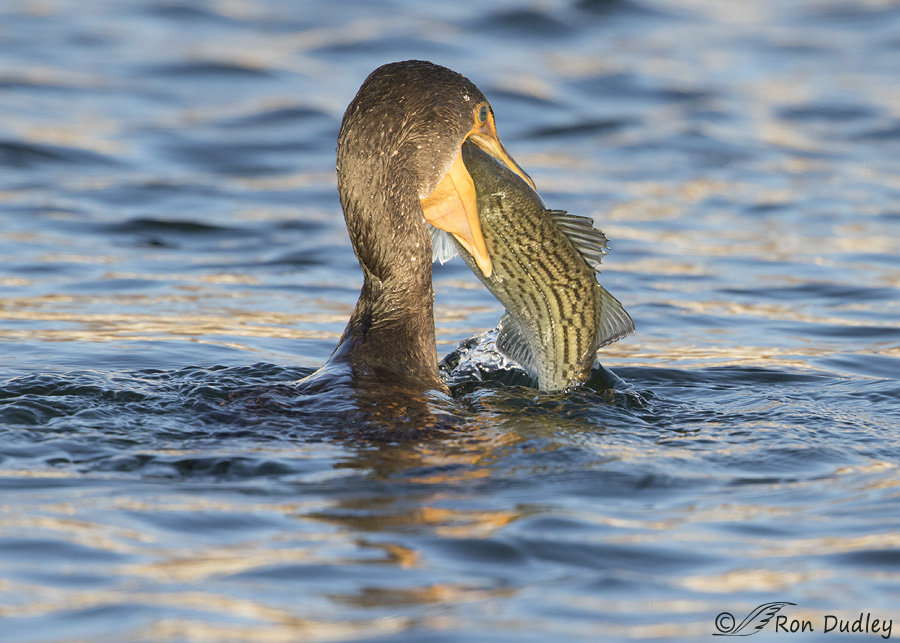
and for the first time that I noticed actually tried to swallow it…
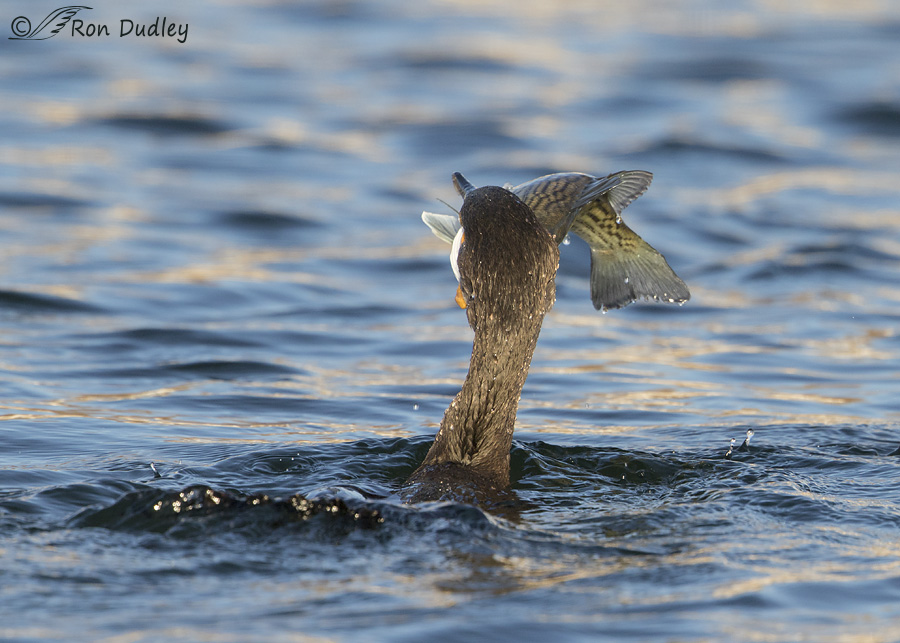
which it did…
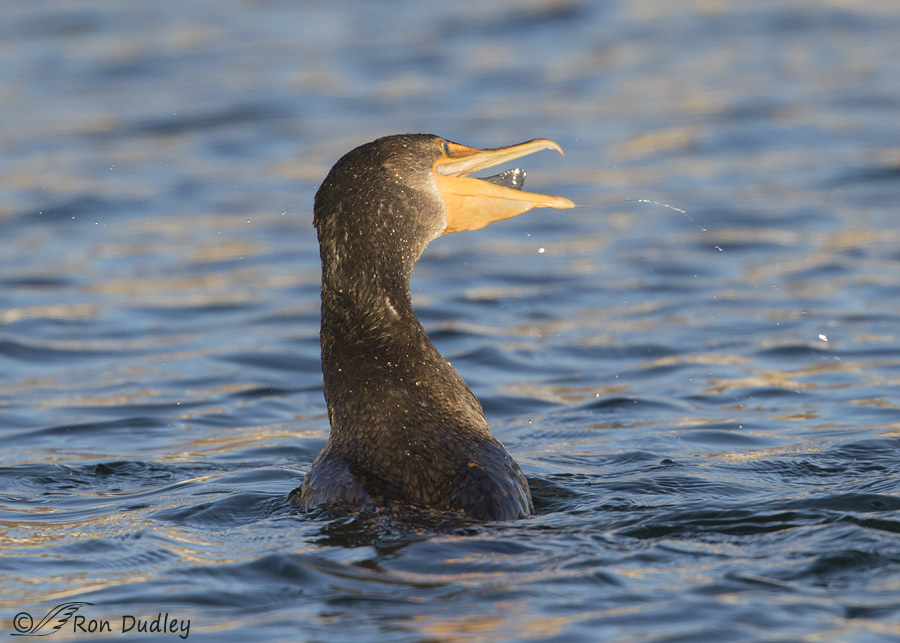
very, very quickly. It had no trouble at all getting the fish down.
It took almost 6 minutes for this little drama to play out and during that time I took 228 photos of the action but after studying those images and thinking about what I saw I’m still somewhat baffled by the behavior of the cormorants and the gulls. Why didn’t one of the cormorants swallow the fish at the first opportunity? At first I thought the fish might be too large to swallow easily but when it was eventually swallowed it went down slick as a whistle and very, very quickly so I suspect that the size of the fish wasn’t a problem (cormorants are known for their ability to swallow exceptionally large fish).
I also have to wonder why the gulls grabbed and then released the fish several times. As a friend said on Facebook “When a California Gull rejects food, you know there’s something odd going on. They aren’t exactly picky eaters”. Perhaps it was too large for the gulls to fly with but I doubt it…
I suppose another possibility for both the cormorants and the gulls is that they were intimidated by those menacing-looking spines in the dorsal fins of the fish. As many fishermen have painfully learned the hard way some fish species use those spines as defensive weapons.
Whatever the actual reason for the behaviors this was one of those exciting times for the photographer when the shooting goes from slow to fast and furious in a heartbeat. Whenever that happens I’m always glad I have a huge memory card, a camera buffer that doesn’t fill quickly and a fast burst rate.
Believe me, it’s truly a sickening feeling to press the shutter button at an important moment and have nothing happen…
Ron


Ron,
Great series and interesting behavior. I would have to admit that I shoot with a smaller buffer and slower burst rate. It is frustrating when the buffer fills and the best part of the show goes on without me.
Alas,
Stephen
Great behavioral series Ron.
Charlotte
Very interesting Ron. The cormorants have a very unique shape to their bills. Must be for “hooking” and holding onto fish? Although this is a far fetched idea, it as almost as if the fish was putting out a defensive measure (odor, slime, electricity, ?) for the birds to keep giving up on it? Do you know what kind of fish it was?
“Do you know what kind of fish it was?”
Not for sure, Ed. DWR plants rainbows and albino rainbows in that pond but folks who tire of their aquarium fish often dump them there too. I’ve also seen weather loaches in that pond and I’m sure there are other exotics too.
Really interesting series!
Shots 5 and 6 are my favorites, and 7-11 are also great. I especially enjoy the position of the head and curious look in the eye of the cormorant in number 10. And the color of the water in number 3 is also very nice.
Maybe they initially resisted eating the fish because of the spines on its dorsal…I’m surprised that cormorant was able to swallow such a big fish, though I’ve seen a big mallard hybrid swallow a 5 1/2 inch fish. Ironically my friend and I were fishing at the time, and the duck was only 20 or so feet away from us. A lady nearby shouted over at us “at least you know they’re in there!”
I’ve had mergansers perform better than me when I was fishing, Levi. At the time I was convinced they were just trying to rub it in…
Maybe so…
By the way, you tagged this post “California quail”, and I think you meant to write California Gull?
Ha, good eye, Levi. I’ll correct it. Thanks!
Ron I don’t agree with full theory because the herons kept right on fishing and swallowed next four fish that were small.
In the case of your herons it does appear that we can rule out the “full theory”, Marina.
Thank you for sharing the mystery, and your wonder.
I hope that if ever I become food my end is quicker.
An appropriate wish for all of us, EC (except perhaps for a politician or two that come to mind…).
Poor fish….
Someone’s gotta be food…
In looking at the photos and reading the narrative I was thinking that the fish might be a species that the birds would find inedible for some reason. But clearly that was not the case. It is especially interesting that the Gull would have rejected the fish – I didn’t think they ever rejected anything that was apparently edible.
What you say about gulls is very true, Susan – especially California Gulls in my experience!
Perhaps the fish had too much fight in it. The birds needed to exhaust it in order to swallow it to avoid being spiked by the dorsal fin?
Could be, April, but I truly doubt that was the reason. From the moment I first saw the fish it was so lethargic and stunned that it was barely moving.
But who knows – I certainly don’t…
Interesting! Amazing they can actually swallow something that large! Spines may be an issue, BUT as Dick mentioned perhaps the Cormorants were already full. Gulls are a puzzle tho. They have interesting bills – didn’t realize until one of my photo’s last spring that eagles have a notch in their lower mandible that the hook fits in. Would be nice if they could/would talk!
Judy, I’d be surprised if the reason the cormorants didn’t swallow the fish initially was because they were too full. If they were full then they’d still be full 6 minutes later when one of the cormorants DID swallow the fish.
Another fascinating behavioral series! Wow! The Cormorants and Gull make me think of the way a cat will “play” with a mouse or lizard before finally dispatching it.
I suppose it could be play, Marty, but if it was I’m surprised that multiple birds of two different species would be doing the same thing at the same time. Perhaps play is contagious for birds just as it can be for humans…???
Wow that is one huge fish and that was some amazing action you caught!!!! The same thing happened at my pond but with herons they would catch a huge fish but release it and move on . In the summer I would see them spend an entire hour trying to swallow a catfish . My theory ( just a theory) for my pond is the pond is low this time of year and fishing is easy!!! So why swallow a big one when there’s lots of easier ones to swallow ??? The fish the heron released looked exactly like the fish in your picture . Maybe it’s that species . But I felt it was size and the abundance of smaller fish there’s 9 herons and 1 egret numerous ducks fishing that pond.
I wish the darned birds could talk and explain their actions!
Very interesting Ron.
I think Cormorants and Gulls are creatures of opportunity and will go after any food item if the opportunity presents itself. But, how about if they were already full? Would they have tried to put the fish head first down their gullet if they were already satiated? Wouldn’t they have shown interest because they are predators, but would have dropped it because they didn’t have the motivation to continue? Just a thought.
“But, how about if they were already full?”
Interesting thought, Dick. However, the bird that eventually swallowed the fish was one of the original two that had several previous opportunities with that fish and didn’t even attempt to swallow it. If it had been full at first it also would have been full 6 minutes later…